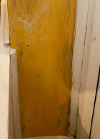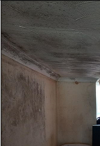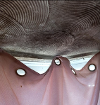Damp and Mould
Damp, Mould and Condensation Overview
Damp, mould, and condensation are frequent household problems that come from excess moisture that gathers on surfaces in your home.
If you've seen mould in your home, it's essential to get rid of it as soon as possible.
These pages have been designed to offer guidance and information about damp, mould and condensation.
These pages provide support and guidance for all Breckland residents including those who own their home.
What follows is further information on the main causes of damp and mould, grants and funding, how to prevent damp and mould in your home and much more.
Unfortunately, if you own your home, we are unable to inspect your property - but the information found here should be useful to you.
The main causes of damp and mould in your home
There are 3 main causes of damp and mould within properties:
- penetrating damp
- rising damp
- condensation, leading to mould growth
What is mould?
Mould is a part of the fungi family including yeast and mushrooms. Individually it is tiny and grows in clusters in moist and damp areas where there is a lack of air. There are so many types of mould that scientists don't know the exact figure, but they believe there are over 100,000 different varieties.
Who is affected?
Everyone can be affected by mould, but certain people are more susceptible, such as:
- the young (including babies and children)
- older people
- those living in overcrowded conditions
- Costly heating and low income
- those who have asthma or other breathing problems, (bronchitis/emphysema etc)
- Properties of an EPC rating of D and below
- those with allergies or skin problems
- those who have a weakened immune system
What is penetrating damp?
Penetrating damp is when water gets into your home through the brickwork. This kind of damp can appear anywhere in your walls and usually happens when:
- there is a leak in the pipes
- there is damage to the guttering or facias
- the brickwork is old or damaged
This kind of damp can be reasonably easily treated by fixing the fault.
The signs of penetrating damp are:
- damaged/misshapen plaster - plaster will blister, show signs of disintegration or signs of 'salting
- localised dampness
- mould growth
- damaged internal decoration
- rotting floor timbers or skirting boards
The images were taken from a top floor flat. The block has a flat roof and is suspected of having had poor roof maintenance over the last few years, allowing water ingress. This has resulted in penetrating / falling damp to affect all exterior walls of the flat.
What is rising damp?
Rising damp is where water seeps up through the walls from below. The signs of this are on the lower parts of the wall such as the skirting boards going soft or the peeling of wallpaper and paint as the water is coming up from the ground. This usually happens because of poor damp proofing that is built into walls to stop this.
Fixing this kind of damp involves replacing the damp-proof course where there is the problem. Once this is fixed, we can then move on to repairing the damage to the walls and skirting.
The signs of rising damp are:
- damp or wet patches appearing on walls
- salts within the flaky or bubbling plaster
- rotten skirting boards and flooring
- damp and musty smell
- rusting iron and steel fasteners
- crumbling bricks and mortar between bricks
The images are from a rural semi-detached property suffering from rising damp downstairs due to the front and rear gardens frequently flooding due to a combination of factors.
These were namely the field drainage channel across the road having become clogged with silt, plant debris and water. Clogged storm drains near the property further exacerbating the issue. The front garden being at a lower level than both the road and drain resulting in frequent flooding with the heavy rain fall.
What is condensation?
Condensation is the little droplets of water that you see on your windows on a cold morning or the mist on mirrors or cold surfaces such as tiles or walls when you have a bath or shower.
This is the most common cause of damp and mould.
The condensation season runs from October through to May.
Condensation doesn't just happen on windows or in the bathroom though - it can form on any cold surface in your home, such as near windows, in corners, and behind wardrobes and cupboards for example. You can usually tell if your damp is condensation as it does not leave a tidemark around the edges of the damp patch. If there is a 'tidemark' this dampness might have another cause, such as water leaking into your home from a plumbing fault, loose roof tiles or rising damp.
Common signs of damp inside a house are:
- damp and musty smell
- the appearance of mould or mildew on walls, floors or ceilings
- walls, floors or ceilings that feel cold or damp
- dark or discoloured patches on walls or plaster
- lifting or peeling wallpaper
- excessive condensation on windows
The images are from a small one bedroomed house. Due to an overcrowding situation the humidity levels were high and the low-level background ventilation, and rapid mechanical extraction was poor. This resulted in mould growth and dampness throughout the dwelling
The Centre for Sustainable Energy (CSE) website has further images on the types of damage that is caused by damp and condensation and has further useful information on how to treat and prevent it.
Visit the Centre for Sustainable Energy website for further information. (opens new window)
What you can do to help prevent damp and mould in your home
There are some simple steps you can take as a tenant to help prevent the development of condensation and spread of mould in your home.
Ventilate your home to help stop the build-up of moisture by:
- Drying any surfaces, including wet windows and frames regularly
- Keeping trickle vents open in window frames
- Opening windows, even if only slightly
- When washing, drying clothes, and bathing, open windows and keep interior doors closed
- When cooking, open windows and keep pots and pans covered with lids
- Dry clothes outdoors if possible, and use a ventilated tumble dryer if drying indoors
- Ensuring all extractor fans are used when necessary, particularly when showering or bathing
- Leaving a gap between walls and furniture to allow the air to flow
- Don't overfill cupboards and wardrobes - make sure there is enough space for air to flow
- Don't block air vents, air bricks or trickle vents - these help to keep the air moving
- Heat your home effectively. It is best, where possible, to have a constant, low background heat which helps to create warmer surfaces and reduces the chance of damp, condensation, and mould.
If you do spot any mould developing, treat it straight away to prevent it spreading by washing the surface with a fungal wash using a dry, clean cloth. If painting an affected area use a fungicidal paint. Most wallpaper paste contains a fungicide to prevent mould growth.
If you are worried or concerned about the presence of damp, mould or condensation in your home always report issues to your landlord in the first instance. Your landlord is responsible for fixing and repairing the cause of damp. This could include structural problems, leaking internal pipes or poor ventilation including missing/poor working extractor fans.
Further Information
If you are a tenant unsure on your rights or a landlord with questions about your obligations,the Shelter website provides further advice and guidance for both tenants and landlords. (opens new window)
If you are a tenant and you are worried about the potential of damp and mould in your home, please report your repair issues firstly to your landlord. Tenants are often worried about reporting issues to their landlord. This is a genuine concern, but landlords should be given the chance to make improvements before the council can take any action. We can give you support and advice on how to approach your landlord.
We have provided letter templates that tenants can use to report repair issues to their landlord. These templates can be used in email format or text message also.
These templates can be found on ourLetter templates page.
The causes of damp, mould and condensation are varied, and we understand that there is never a 'one size fits' all approach.
Our officers will discuss ways in which through some simple lifestyle changes you can decrease the risk of damp, mould and condensation in your home.
Our officers may use data loggers which are used to carry out long-term monitoring in your home to assess internal humidity, ambient temperatures and dew point temperatures, but this is something that will be discussed with you.
There are several ways we can support you. We support both tenant's and landlord's and hope that together we can improve living conditions for everyone in Breckland.
- Our team can interpret data generated from the data loggers providing guidance and simple lifestyle tips to minimise the risk of damp and mould.
- If a repair issue is reported to us, our experienced Officers may decide an inspection is necessary. We will visit your home with specialist equipment and will suggest recommendations for you and your landlord.
- If required, an improvement notice will be provided to your landlord. We always carry out a follow-up inspection to ensure works have been carried out. Where a landlord has not met their obligations and repairs have not been done, we will commence enforcement activity
Please note, once an improvement notice has been issued by us, evictions are not possible for up to six months and that your landlord should respond to any reports of repairs within 14 days
- Understanding and addressing the health risks of damp and mould in the home (opens new window)
- How to save energy and lower your bills - Help for Households (opens new window)
- Find an energy certificate (opens new window)
- Help from your energy supplier: the Energy Company Obligation (opens new window)
- Moisture balance calculator (opens new window)
Warm Welcome Campaign
The Warm Welcome Campaign is a movement to reconnect individuals and communities across the country all year round.
Warm Welcome Spaces are places full of human warmth, belonging, connection and hope.
To find a warm welcome space near you,please visit The Warm Welcome Spaces website. (opens new window)
Grants and funding
How to submit a disrepair request
Here you can report any concerns you have around damp, mould and any other repair issue you have in your home.
This form is for anyone living in the Breckland area and can be completed by a resident, family member, friend or professional. If you are a private rented or housing association tenant, we can support you.
Please only report repair issues only after you have first reported to your landlord. Please allow a minimum of 14 days for your landlord to respond.
Please provide photographic evidence where possible as this will help our team to triage your request more efficiently.
When completing the report a disrepair form, it is very important you provide as much information as possible as this will help us provide you with the right support from the offset.












